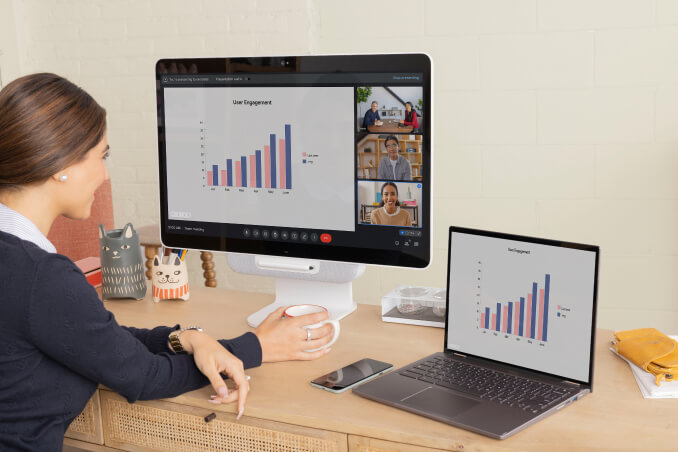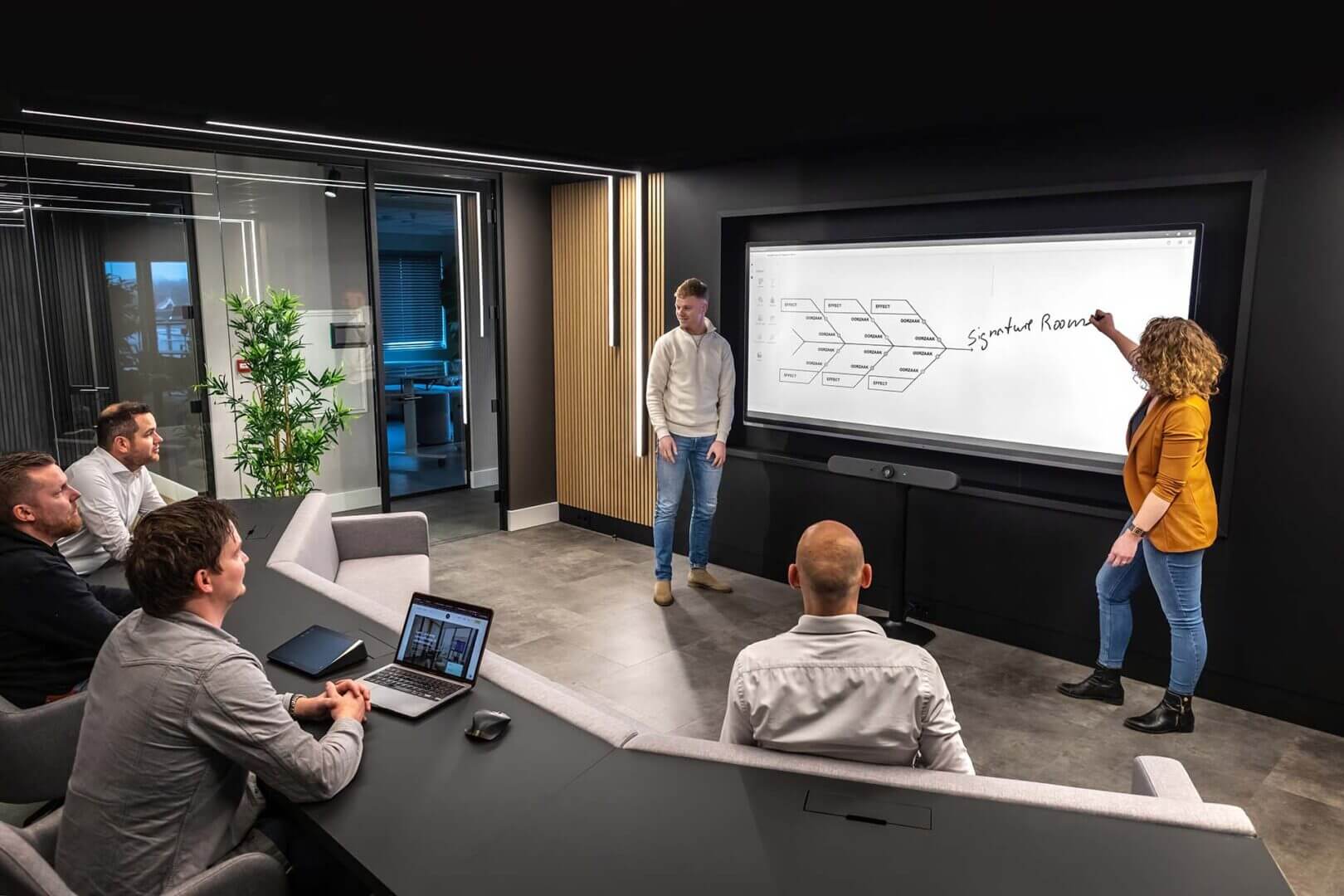
Hybrid work has moved from a short-term necessity to a long-term reality. But simply supporting hybrid work isn’t enough - organizations now face a deeper challenge: building teams that don’t just work together, but work in sync. Coordinated hybrid teamwork is the next evolution of collaboration, where teams align on goals, communicate with clarity, and move forward together, whether they’re in the office or remote.
In traditional workplaces, collaboration often relied on proximity - people gathered around desks or in meeting rooms to solve problems. In hybrid environments, distance creates gaps that can fragment teamwork. Coordinated hybrid teamwork fills those gaps with shared rhythms, intentional communication, and mutual accountability. It’s not about working more, but working smarter - and together.

Many teams collaborate, but few coordinate. Collaboration happens when people work together on shared tasks. Coordination happens when they align their efforts toward shared outcomes, minimizing duplication and confusion along the way.
In today’s hybrid workplaces, teams that lack coordination often face familiar problems: missed deadlines, duplicated efforts, unclear priorities, and frustration that slows down progress. Without shared processes and purposeful connection, silos form. Remote employees may be left out of key conversations, while in-person teams default to ad hoc problem-solving that excludes others.
On the other hand, when team collaboration strategies are intentional and aligned, teams move faster, adapt to change more easily, and build solutions that reflect diverse perspectives across locations. Coordination transforms scattered effort into collective momentum.
Technology enables connection, but culture sustains it. The foundation of coordinated hybrid teamwork is a culture where communication expectations are clear, trust runs deep, and psychological safety allows for honest dialogue.
Teams need shared norms for how they communicate - when asynchronous updates are appropriate, and when live conversations are needed. Clarity on tools, channels, and response times keeps collaboration flowing, not stalling. This kind of clarity creates what modern teams often lack: flow.
Trust and autonomy are equally important. In hybrid work, micromanagement slows down progress and breeds disengagement. Empowered teams - supported by transparent leadership and aligned goals - are more likely to take initiative and drive outcomes without needing constant oversight.
And perhaps most importantly, collaborative work environments must foster psychological safety. In virtual meetings or asynchronous platforms, employees need to feel safe sharing ideas, asking questions, and admitting when something’s unclear. These moments of vulnerability drive innovation and prevent small misunderstandings from becoming big problems.
Cultural values only matter if they shape how teams work day to day. That means creating workflows that reflect and reinforce those values.
Clear workflow management tools help teams organize projects, track progress, and maintain visibility across locations. Tools like shared project boards, collaborative documents, and digital whiteboards give every team member - remote or in-person - a clear view of priorities and deadlines. This transparency helps reduce duplication, avoid bottlenecks, and build alignment across functions.
Beyond tools, teams need rituals that create a rhythm of connection. Weekly standups remove blockers before they stall progress. Retrospectives help teams reflect and improve together. Planning sessions align priorities, and informal moments - whether virtual coffee chats or team-building activities - sustain the human connection that fuels effective work.
Technology like Avocor’s interactive displays enables this rhythm by allowing teams to brainstorm and solve problems together in real time, whether they’re in a shared meeting space or scattered across locations. But it’s how teams use the technology - intentionally and inclusively - that creates real coordination.

Rethinking the Workspace for Modern Collaboration
Physical and digital spaces either support coordination or undermine it. Too often, meeting rooms are designed for in-person convenience rather than hybrid inclusion. The result: remote participants feel like spectators, not contributors.
Hybrid-ready spaces change this. Meeting rooms equipped with intuitive tech - interactive displays, smart cameras, and clear audio systems - bring every voice into the conversation. Flexible layouts and thoughtful room design make it easy for teams to see and hear one another, reducing the friction that often derails hybrid collaboration.
But collaborative work environments aren’t limited to the office. Virtual spaces matter just as much. Teams need to consider whether their digital platforms are designed for transparency and access. Are whiteboards shared in every meeting? Are chat channels used for meaningful discussions, not just status updates? Do remote team members have equal access to information and decision-making as their in-office peers?
Effective hybrid workspaces - physical and virtual - remove barriers between where people work and how they work together.
While tools and workflows matter, it’s leadership that sets the tone for coordinated hybrid teamwork. Leaders create alignment through clear priorities, transparent decision-making, and regular communication.

They also create momentum by encouraging experimentation. Hybrid collaboration is still evolving, and the best leaders give teams permission to test new meeting formats, pilot emerging tools, and iterate on project coordination techniques without fear of failure.
Leadership visibility is critical in distributed environments. Regular town halls, open Q&A sessions, and active participation in collaborative projects show teams that leadership is engaged - and listening. Recognizing cross-team wins, not just individual accomplishments, reinforces the value of coordinated effort.
Most importantly, leaders who model vulnerability, curiosity, and empathy build the trust that fuels coordination. Hybrid teams that feel connected to their leaders work more openly with each other.
Moving from Ad Hoc to Aligned
Many teams today operate in an ad hoc rhythm - responding to messages, reacting to tasks, and pulling together when needed but lacking a shared cadence. Coordinated hybrid teamwork replaces this with purposeful alignment. It’s a shift from asking, “Who’s doing what?” to knowing, “Here’s how we move forward together.”
This shift doesn’t happen overnight. It starts with leadership prioritizing effective team communication and shared processes. It builds through tools that make workflows visible to all. And it’s sustained by a culture where asking questions, sharing updates, and reflecting on progress are part of the team’s DNA.
The impact is tangible: fewer missed deadlines, stronger accountability, faster decision-making, and a collaborative environment where creativity thrives.
Coordinated hybrid teamwork is a competitive advantage in today’s distributed workplaces. It’s not about over-engineering processes or relying solely on tools. It’s about cultivating trust, clarity, and connection - and designing workflows and spaces that support them.
To build a culture of coordinated collaboration, focus on:
When teams align on shared values, adopt clear team collaboration strategies, and make use of purposeful technologies like Avocor’s interactive displays, they build a culture where collaboration isn’t accidental - it’s intentional. Where teams don’t just work side by side, but move forward together.
The future of hybrid work belongs to teams that make coordination a cultural strength - not just a technical solution.
Keep up to date with all the latest from Avocor and partners and get information on upcoming events and exciting product news.
Speak to one of our product specialists and find the perfect solution for you.